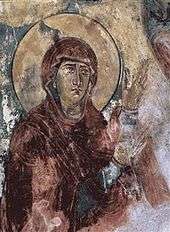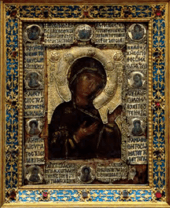Agiosoritissa


The Panagia Agiosoritissa or Hagiosoritissa (Greek: Παναγία ἡ Ἁγιοσορίτισσα) is the name for a type of Marian icon, showing Mary without child, slightly from the side with both hands raised in prayer.
The names used for the icon, Hagiosoritissa and, in Russian, Khalkopratiskaya, derive from the church of the Holy Urn (Greek: Ἁγία Σορός, in reference to the urn containing the Cincture of the Theotokos) in Constantinople's Chalkoprateia (Χαλκοπρατεῖα, "copper market") district. The appellation Ἁγιοσορίτισσα is first recorded in Byzantine seals 11th century, and it appears minted on coins made under Manuel I Komnenos (12th century). In English, the type is also known as Madonna Advocate (the prayer gesture interpreted in the context of intercession).
Such an icon is known to have been in the Hagios Demetrios basilica in Thessalonica in the 6th century, but was lost in the Byzantine Iconoclasm. An early Byzantine icon (7th century?) is preserved in the church of Santa Maria del Rosario Monte Mario, Rome.[1]
The type was widespread in the Byzantine empire and in the Balkans, but less so in Russia. An early Russian example is the Theotokos of Bogolyubovo (12th century). The church of Santa Maria in Via Lata in Rome has a 13th-century icon of this type.
References
- ↑ formerly in S. Agata in Trastevere, moved to San Sisto Vecchio and hence also known as "Madonna of San Sisto", and finally to Santa Maria del Rosario in 1931.
- O. E. Etingof, Агиосоритисса, Православная энциклопедия vol. 1 (2000), p. 254. (Russian)
- David Lathoud, "Le sanctuaire de la Vierge des Chalcopratia", Échos d'Orient 23 (1924), 36–62.
- Tommaso Bertelè, "La Vergine aghiosoritissa nella numismatica bizantina", Revue des études byzantines 16 (1958), 233f.
- M. Andaloro, "Note sui temi iconografici della Deesis e dell'Hagiosoritissa", Riv. dell'Istituto Nazionale di Archeologia e Storia dell'Arte 17 (1970), 85–130.
See also
| Wikimedia Commons has media related to Agiosoritissa. |